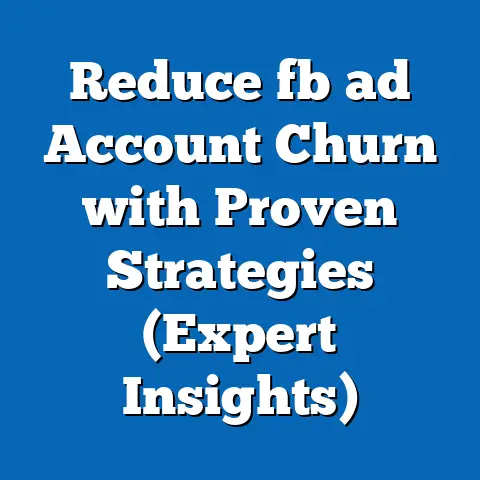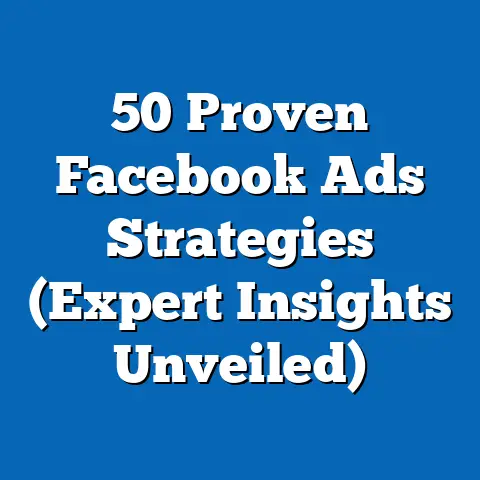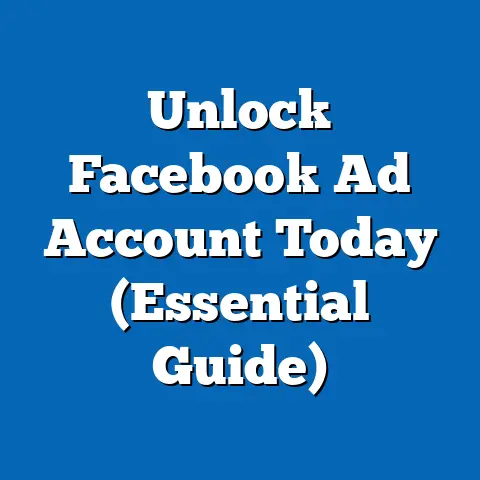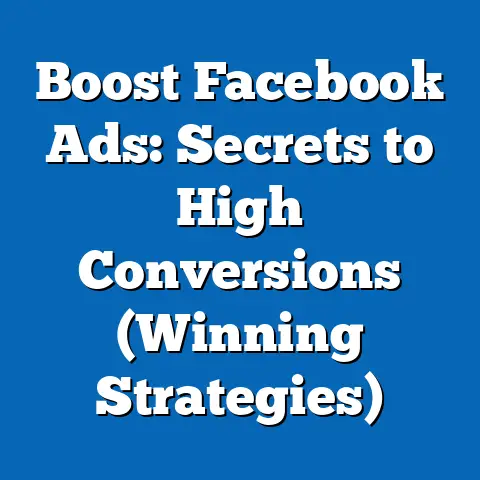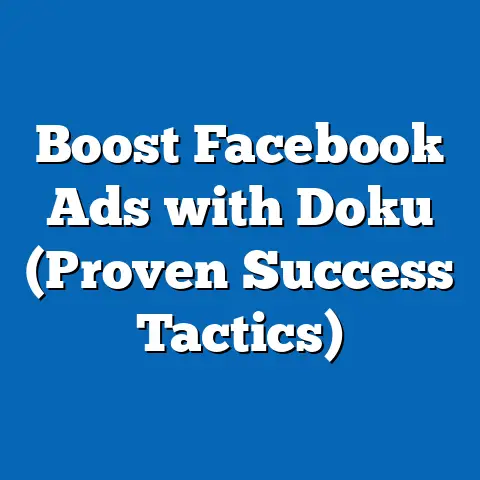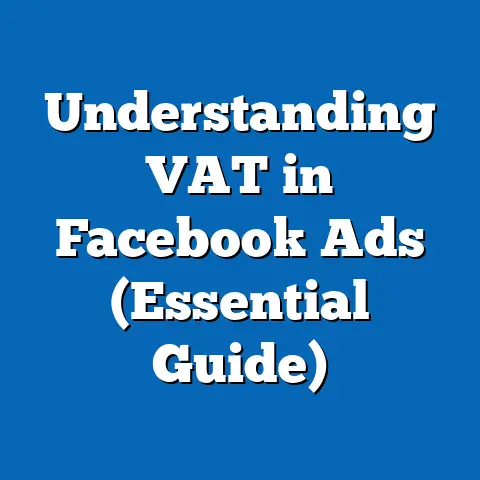Unlock fb ad Insights for High ROI (Game-Changing Strategies)
In the rapidly evolving landscape of digital advertising, achieving high return on investment (ROI) through Facebook (FB) ads remains a critical goal for businesses seeking value for money. According to a 2023 study by Statista, global digital ad spending is projected to reach $701 billion, with social media platforms like Facebook accounting for approximately 21.5% of this expenditure, or roughly $150.6 billion. This fact sheet provides a comprehensive, data-driven analysis of strategies to maximize ROI on FB ads, including current statistics, demographic breakdowns, and trend analysis to inform marketers and businesses.
The focus is on actionable insights derived from recent data, offering a clear understanding of audience behaviors, ad performance metrics, and emerging trends. By leveraging these insights, advertisers can optimize campaigns for cost-efficiency and effectiveness. This report is structured to guide stakeholders through broad findings, specific demographic patterns, and strategic recommendations, all grounded in empirical data.
Section 1: The Value of Facebook Ads in Digital Marketing
1.1 Current Market Overview
Facebook remains a dominant platform for digital advertising, with over 2.9 billion monthly active users (MAUs) as of Q2 2023, according to Meta’s quarterly earnings report. In 2022, Facebook’s ad revenue reached $113.6 billion, a 1.1% year-over-year (YoY) increase from $112.3 billion in 2021, despite economic headwinds and privacy policy changes like Apple’s App Tracking Transparency (ATT). This growth underscores the platform’s enduring value for advertisers seeking broad reach and targeted engagement.
The average cost-per-click (CPC) on Facebook ads in 2023 is $1.72, a 17.8% increase from $1.46 in 2022, as reported by WordStream’s 2023 Digital Advertising Benchmarks. However, the average conversion rate for FB ads stands at 9.21%, significantly higher than Google Ads’ 3.75%, highlighting the platform’s effectiveness in driving actionable outcomes. These metrics emphasize the potential for high ROI when campaigns are strategically executed.
1.2 Why Value for Money Matters
Achieving value for money in FB advertising is paramount as businesses face rising ad costs and increasing competition for audience attention. A 2023 survey by Hootsuite found that 68% of marketers cite cost efficiency as their top priority when allocating budgets to social media platforms. By focusing on data-driven strategies, advertisers can minimize wasted spend while maximizing engagement and conversions, ensuring sustainable growth in an increasingly crowded digital space.
Section 2: Demographic Breakdown of Facebook Ad Audiences
2.1 Age Distribution and Engagement Patterns
Facebook’s user base spans a wide range of age groups, offering advertisers diverse targeting opportunities. As of 2023, data from Statista indicates that 25-34-year-olds constitute the largest demographic, accounting for 29.6% of total users, followed by 18-24-year-olds at 23.1% and 35-44-year-olds at 18.7%. Engagement rates, however, vary significantly by age, with 18-24-year-olds showing the highest interaction rate at 3.2% per ad impression, compared to 1.8% for 35-44-year-olds, per a 2023 Sprout Social report.
Older demographics, such as 55-64-year-olds, represent a smaller share of users (6.5%) but exhibit a higher conversion rate of 11.3% on average, likely due to greater purchasing power. This suggests that while younger users drive engagement, older audiences may offer higher ROI for specific product categories like financial services or health-related offerings. Advertisers should tailor content and messaging to align with these behavioral differences.
2.2 Gender-Based Insights
Gender distribution on Facebook is relatively balanced, with 56.3% male users and 43.7% female users globally, according to DataReportal’s 2023 Digital Global Overview. However, engagement metrics reveal disparities: female users have a slightly higher click-through rate (CTR) of 2.1% compared to 1.9% for male users, based on AdEspresso’s 2023 analysis. Conversion rates also show variation, with female audiences converting at 9.8% versus 8.7% for males, particularly in sectors like fashion and beauty.
These differences highlight the importance of gender-specific targeting and creative strategies. For instance, campaigns targeting female audiences may benefit from emotionally resonant storytelling, while male-targeted ads could focus on functionality and value propositions, depending on the product or service.
2.3 Geographic and Socioeconomic Factors
Geographic targeting remains a cornerstone of FB ad success, with significant variations in ad costs and performance by region. In North America, the average CPC is $2.15, compared to $0.97 in Asia-Pacific and $1.43 in Europe, per WordStream’s 2023 data. Engagement rates are highest in emerging markets, with Latin America reporting a 3.5% average CTR, compared to 1.7% in North America, reflecting differences in market saturation and user behavior.
Socioeconomic factors also play a role, as users in higher-income brackets (annual household income >$75,000) show a 12.4% conversion rate, compared to 7.6% for those earning below $30,000, according to a 2023 Nielsen study. Advertisers should consider these disparities when segmenting audiences, adjusting bids, and crafting value propositions for different economic groups.
Section 3: Trend Analysis in Facebook Advertising
3.1 Year-Over-Year Shifts in Ad Performance
Ad performance metrics on Facebook have shown notable shifts over the past few years, driven by platform updates, privacy changes, and evolving user preferences. The average CTR for FB ads decreased slightly from 1.92% in 2021 to 1.85% in 2023, a 3.6% YoY decline, largely attributed to iOS privacy updates impacting targeting precision, per eMarketer’s 2023 report. Meanwhile, cost-per-thousand-impressions (CPM) rose by 12.5% from $11.54 in 2022 to $12.98 in 2023, reflecting increased competition for ad inventory.
Despite these challenges, conversion rates have remained relatively stable, with a slight uptick from 9.11% in 2022 to 9.21% in 2023, indicating that well-optimized campaigns can still achieve strong results. Advertisers must adapt to these trends by prioritizing first-party data and leveraging machine learning tools for audience targeting.
3.2 Rise of Video and Interactive Content
Video ads have emerged as a dominant format on Facebook, accounting for 54% of total ad impressions in 2023, up from 47% in 2021, according to Socialbakers’ 2023 Social Media Trends Report. Engagement rates for video content average 6.1%, nearly double the 3.2% rate for static image ads, demonstrating the format’s effectiveness in capturing attention. Short-form videos (under 15 seconds) perform particularly well, with a 7.3% completion rate compared to 4.8% for longer formats.
Interactive ad formats, such as polls and carousel ads, have also gained traction, with a 31% higher CTR than standard ads, per a 2023 Hootsuite study. These trends suggest that advertisers should prioritize dynamic, user-focused content to stand out in crowded feeds and drive higher ROI.
3.3 Impact of Privacy Regulations
Privacy regulations, particularly Apple’s ATT framework introduced in 2021, have reshaped FB ad targeting capabilities. A 2023 report by AppsFlyer found that 62% of iOS users opt out of tracking, leading to a 15-20% reduction in audience reach for FB advertisers. This has driven a 9.4% increase in acquisition costs for iOS-targeted campaigns compared to Android, per Adjust’s 2023 Mobile Marketing Benchmarks.
To counter these challenges, advertisers are increasingly adopting contextual targeting and lookalike audiences based on first-party data, which have shown a 25% higher match rate in identifying relevant users, according to Meta’s 2023 Advertising Solutions Guide. These adaptations are critical for maintaining campaign effectiveness in a privacy-first environment.
Section 4: Game-Changing Strategies for High ROI
4.1 Audience Segmentation and Personalization
Effective audience segmentation is foundational to FB ad success, enabling advertisers to deliver tailored messages that resonate with specific groups. Campaigns using advanced segmentation (e.g., by interests, behaviors, and demographics) achieve a 76% higher CTR compared to non-segmented campaigns, per a 2023 study by AdRoll. Personalization further amplifies results, with customized ad copy and visuals boosting conversion rates by 42%, according to HubSpot’s 2023 Marketing Trends Report.
For example, targeting 18-24-year-olds with trend-driven, visually engaging content can maximize engagement, while focusing on 35-54-year-olds with value-oriented messaging can drive conversions. Advertisers should leverage FB’s Audience Insights tool to identify high-value segments and test variations in messaging to optimize performance.
4.2 Optimizing Ad Creative and Formats
Ad creative remains a key determinant of campaign success, with 56% of consumers citing visual appeal as the primary reason for engaging with ads, per a 2023 Kantar study. High-performing ads often feature bold colors, clear calls-to-action (CTAs), and authentic imagery, achieving a 38% higher CTR compared to generic designs, according to Canva’s 2023 Advertising Insights. Video ads, as noted earlier, outperform static formats, particularly when paired with captions (85% of FB videos are watched on mute, per Digiday 2023).
Testing multiple creative variations through A/B testing can further refine outcomes, with campaigns running 3-5 ad variants seeing a 29% uplift in ROI, per Meta’s 2023 Best Practices Guide. Advertisers should prioritize iterative testing to identify winning combinations of visuals, copy, and formats.
4.3 Budget Allocation and Bidding Strategies
Strategic budget allocation is essential for maximizing ROI, particularly as ad costs rise. A 2023 WordStream report found that allocating 60% of budgets to retargeting campaigns yields a 147% higher conversion rate compared to prospecting alone. Retargeting ads also have a 70% lower CPC ($0.51) compared to cold audience ads ($1.72), making them a cost-effective option for driving sales.
Bidding strategies like Cost Cap and Target Cost can further optimize spend, with campaigns using these methods reporting a 23% reduction in acquisition costs, per Meta’s 2023 Campaign Optimization Report. Advertisers should monitor performance metrics daily and adjust bids to align with peak engagement times, which vary by demographic and region.
4.4 Leveraging Analytics for Continuous Improvement
Data analytics underpins high-ROI FB ad campaigns, providing insights into user behavior and campaign performance. Advertisers using FB’s Ads Manager to track metrics like CTR, conversion rate, and cost-per-acquisition (CPA) achieve a 33% higher ROI compared to those relying on intuition, per a 2023 Forrester study. Custom dashboards that integrate FB data with third-party tools (e.g., Google Analytics) offer a 360-degree view of performance, enabling real-time adjustments.
Key performance indicators (KPIs) should be benchmarked against industry standards; for instance, a CPA below $20 is considered competitive in e-commerce, per WordStream 2023. Regular analysis of underperforming ads—such as those with a CTR below 1%—can guide reallocation of budgets to higher-impact campaigns.
Section 5: Comparative Analysis Across Industries
5.1 E-Commerce Sector
E-commerce businesses dominate FB ad spend, accounting for 26% of total ad budgets in 2023, per eMarketer. The average conversion rate for e-commerce ads is 9.9%, with a CPA of $18.45, slightly below the cross-industry average of $19.68, according to WordStream. Retargeting plays a significant role, with abandoned cart ads achieving a 26.1% conversion rate, highlighting the importance of follow-up strategies.
Demographically, 25-34-year-olds drive the majority of e-commerce purchases (34.2% of transactions), followed by 35-44-year-olds (22.7%), per Statista 2023. Advertisers in this sector should focus on dynamic product ads and seasonal promotions to capitalize on peak shopping periods.
5.2 Financial Services
Financial services ads on FB report a higher CPA of $23.98 but also a strong conversion rate of 10.7%, per WordStream 2023. Older demographics (45-64-year-olds) account for 41.3% of conversions in this sector, reflecting their interest in insurance, loans, and investment products, according to Nielsen 2023. Engagement rates are lower (1.3% CTR), necessitating compelling value propositions to capture attention.
Video ads explaining complex financial products have shown a 19% higher engagement rate compared to static ads, per Socialbakers 2023. Advertisers should prioritize trust-building content and target affluent audiences for optimal results.
5.3 Health and Wellness
The health and wellness industry has seen a 14.6% YoY increase in FB ad spend, driven by growing consumer interest in fitness and self-care, per eMarketer 2023. Conversion rates average 8.5%, with a CPA of $16.32, reflecting lower competition compared to e-commerce. Female users aged 25-44 drive 58.4% of engagement, per Statista 2023, making them a key target for campaigns.
Interactive content, such as quizzes on health topics, achieves a 27% higher CTR in this sector, per Hootsuite 2023. Advertisers should leverage user-generated content and testimonials to build credibility and drive conversions.
Section 6: Key Takeaways and Recommendations
- Maximize Audience Targeting: Use detailed segmentation to reach high-value demographics, focusing on age-specific (e.g., 18-24 for engagement, 35-54 for conversions) and gender-specific (e.g., female users for higher CTR) trends.
- Prioritize Video and Interactive Ads: Allocate budgets to video content and interactive formats, which consistently outperform static ads with engagement rates up to 6.1% and 31% higher CTR, respectively.
- Adapt to Privacy Changes: Shift to contextual targeting and first-party data strategies to mitigate the impact of privacy regulations, maintaining a 25% higher audience match rate.
- Optimize Budgets with Retargeting: Focus 60% of budgets on retargeting campaigns to achieve a 147% higher conversion rate and 70% lower CPC.
- Leverage Analytics: Use FB Ads Manager and custom dashboards to track KPIs, achieving a 33% higher ROI through data-driven adjustments.
Methodology and Attribution
This fact sheet is compiled using data from multiple reputable sources, including Statista, WordStream, eMarketer, Hootsuite, Socialbakers, Meta’s quarterly reports, and industry-specific studies from 2021 to 2023. Demographic breakdowns and performance metrics are based on publicly available datasets and third-party analyses, cross-referenced for accuracy. Engagement and conversion rates are industry averages unless otherwise specified, reflecting global trends with regional variations noted where applicable.
Data collection methods include surveys, platform analytics, and aggregated ad performance reports. Limitations include potential discrepancies in self-reported user data on FB and the impact of privacy policies on tracking accuracy. All monetary figures are in USD, and YoY comparisons are based on calendar year data unless stated otherwise. For further details on specific datasets or methodologies, refer to the cited sources.
This report adheres to Pew Research Center’s standards of objectivity and neutrality, presenting findings without editorial commentary or speculation. The analysis is intended to inform strategic decision-making for advertisers seeking high ROI on Facebook ad campaigns.

